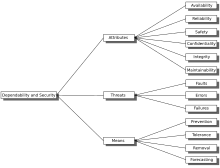토착민 목록
List of Indigenous peoples원주민들은[a] 한 지역의 가장 초기에 알려진 거주자들과 그들의 후손들이며, 특히 지금은 지배적인 정착민 집단에 의해 식민지가 된 사람들입니다.그러나 이 용어는 권위 있는 정의가[1] 하나도 없으며 다양한 사람들과 문화를 설명하는 데 사용될 수 있습니다.[2][3]현대적 맥락에서 원주민이라는 용어는 아메리카 원주민을 아메리카 대륙의 유럽 정착민과 구분하기 위해 사용된 유럽인들에 의해 처음 사용되었으며, 사하라 사막 이남의 아프리카인들로부터도 노예가 되어 아메리카로 끌려왔습니다.이 용어는 1646년 토마스 브라운(Thomas Browne)에 의해 처음 사용되었을 수도 있는데, 그는 "현재 많은 지역에 스페인 사람들 아래 복무하는 흑인들이 있지만, 콜럼버스가 발견된 이후로 모두 아프리카에서 수송되었습니까? 그리고 아메리카 토착민이나 적절한 원주민이 아닙니다."라고 말했습니다.[4][5]
특정 지역의 최초 거주자와 관련된 초기 문화의 전통 또는 다른 측면을 유지할 때 사람들은 보통 "토종"으로 묘사됩니다.[6]많은 사람들이 복장, 종교 또는 언어와 같은 식민지 문화의 실질적인 요소를 채택했기 때문에 모든 토착민들이 이러한 특성을 공유하는 것은 아닙니다.토착민들은 특정 지역(정착지)에 정착하거나, 넓은 영토에 걸쳐 유목 생활을 하거나, 재정착될 수 있지만, 일반적으로 그들이 의존하는 특정 지역과 역사적으로 연관되어 있습니다.토착 사회는 남극을 제외한 세계의 거주하는 모든 기후대와 대륙에서 발견됩니다.[7]전 세계에는 약 5천 개의 원주민 국가들이 있습니다.[8]
원주민들의 고향은 역사적으로 더 큰 민족 집단들에 의해 식민지화되어 왔으며, 이들은 인종적, 종교적 우월성, 토지 이용, 경제적 기회에 대한 신념으로 식민지화를 정당화했습니다.[9]전 세계의 수천 개의 원주민 국가들은 현재 그들이 다수 민족이 아닌 국가들에 살고 있습니다.[10]토착민들은 그들의 주권, 경제적 안녕, 언어, 앎의 방식, 그리고 그들의 문화가 의존하는 자원에 대한 접근에 대한 위협에 계속 직면하고 있습니다.토착민의 권리는 유엔, 국제노동기구, 세계은행에 의해 국제법에 명시되었습니다.[11]2007년 UN은 회원국의 국가 정책을 문화, 정체성, 언어, 의식, 고용, 보건, 교육 및 천연 자원에 대한 접근에 대한 권리를 포함한 원주민의 집단적 권리로 안내하기 위해 원주민 권리에 관한 선언(UNDRIP)을 발표했습니다.[12]
토착민들의 전세계 총 인구는 보통 2억 5천만에서 6억명 사이입니다.[13]원주민으로 여겨지는 사람에 대한 공식 명칭과 용어는 국가, 민족 및 기타 요인에 따라 다릅니다.[2]아메리카, 오스트레일리아, 뉴질랜드에서는 유럽인들이 정착하기 전에 그곳에 살았던 민족의 후손들에게 토착민 지위가 문제없이 적용되는 경우가 많습니다.그러나 아시아와 아프리카에서 원주민 지위에 대한 정의는 특정 민족에 의해 거부되거나 다른 [14]맥락에서 "원주민"으로 간주되지 않을 수 있는 소수 민족 및 억압받는 민족에 적용됩니다.[15]따라서 인구 수치가 덜 명확하고 급격하게 변동할 수 있습니다.[2]토착민의 개념은 사미족과 같은 집단을 제외하고는 극히 소수의 토착 집단이 인정되는 유럽에서는 거의 사용되지 않습니다.[16]정의.
원주민 공동체, 민족 및 국가는 그들의 영토에서 발전한 침략 이전 및 식민지 이전의 사회와 역사적 연속성을 가지고 있으며, 현재 그러한 영토 또는 그들의 일부에 지배적인 사회의 다른 부문과 구별된다고 생각할 수 있습니다.그들은 현재 사회의 비지배적 부문을 형성하고 있으며, 그들의 문화적 패턴, 사회 제도 및 법 제도에 따라 조상의 영토와 민족적 정체성을 보존, 발전시키고 후세에 전달할 것을 결의하고 있습니다.[17]
이 역사적 연속성은 다음 요소 중 하나 이상의 현재에 도달하는 장기간 동안의 연속성으로 구성될 수 있습니다.
- 조상 땅 또는 적어도 일부의 점유
- 이 땅들의 원래 거주자들과 공통된 혈통
- 일반적인 문화, 또는 특정한 표현(종교, 부족 체제 하에서 생활, 원주민 공동체의 회원권, 복장, 생계 수단, 생활 방식 등)
- 언어(가정이나 가정에서 유일한 언어, 모국어, 습관적인 의사소통 수단으로 사용되거나 주 언어, 선호하는 언어, 일반 언어 또는 일반 언어로 사용되는 언어)
- 국가의 특정 지역 또는 세계의 특정 지역에서의 거주
- 기타 관련 요인.
- 원주민은 개별적인 기준에서 자기 동일시를 통해 이러한 원주민 집단에 속하며(집단의식), 이러한 집단에 의해 그 구성원의 하나로 인식되고 수용되는 사람입니다(집단에 의한 수용).이를 통해 이러한 공동체는 외부의 간섭 없이 주권적 권리와 자신의 소유자를 결정할 수 있는 권한을 유지하게 됩니다.[18]
사하라 이남 아프리카
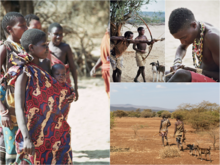












아프리카 오대호
- 아바구스ii:케냐[19][20]
- 하자(하자베):탄자니아, 싱기다 지역: 에야시 호수 남동쪽,[citation needed] 남쪽, 북서쪽
- Iraqw: 탄자니아[21][22]
- 칼렌진:케냐[23][24]
- 키쿠유: 케냐[25][26]
- 루하: 케냐[27][28]
- 마사이: 케냐, 탄자니아[29][30][31]
- 렌딜:케냐[32][33]
- 삼부루: 케냐, 탄자니아[23][34]
- Sandawe:탄자니아, 도도마 지역: 콘도아 지역, 부와 음퐁드 강 사이,[citation needed] 싱기다 지역
- 피그미족:
- 트와[citation 필요]
- 방웨울루 트와: 북잠비아, [citation needed]방웨울루 늪,
- 오대호 트와: 르완다, 부룬디, 우간다, 콩고민주공화국[citation needed]
- 카프웨 트와: 잠비아 남부, 카푸에 평원[citation needed]
- 루캉가 트와: 중앙 잠비아, 루캉가[citation needed] 늪
- 은수아: 우간다[citation needed] 서부
- 트와[citation 필요]
중앙아프리카
아프리카의 뿔
- 아파르족(Qafar/'Afar): 지부티의 아파르 삼각지대, 에리트레아, 에티오피아[35][36]
- 암하라: 에티오피아[37][38][39][40]
- 반나(Banna): 에티오피아 남서부, 남부 국가, 국적 및 국민 지역([41][42]Southwest Ethiopia, Southern Nations, Nationality, and People Region)
- Basketo:에티오피아 남서부, 남부 국가, 국적, 국민 지역(SNNPR)[43]
- Berta (Funj):서부 에티오피아, 베니샨굴-구무즈 지역, 극동 수단[44][45]
- 부르지: 남부 에티오피아, 남부 국가, 민족, 국민 지역 (SNNPR)[46][47]
- 게데오: 남부 에티오피아, 남부 국가, 민족, 국민 지역 (SNNPR)[47][48]
- 구무즈: 에티오피아 서부, 베니샨굴-구무즈 지역, 극동 수단[49][50]
- 하머: 에티오피아 남서부, 남부 국가, 국적 및 국민 지역(SNNPR)[51][52]
- 카로(Karo): 에티오피아 남서부, 남부 국가, 국적 및 국민 지역([53][54]SNNPR)
- 쿠나마: 서부 에리트레아, 가쉬바르카 지역, 극동 수단[55][56]
- Male: 남서부 에티오피아, 남부 국가, 민족, 국민 지역 (SNNPR)[57][58]
- 무르시(Mursi): 주로 데부브 오모 구역, 남부 국가, 민족 및 민족 지역, 에티오피아[59][51] 남서부
- 나라: 서부 에리트레아, 가쉬바르카 지역, 극동 수단[56][55]
- 오로모족:에티오피아, 케냐[54]
- 사호: 중부 에리트레아, 북홍해 지역의[60][61] 남부
- 시나샤(시나샤):에티오피아[62] 북서부
- Sidama: 남부 에티오피아, 남부 국가, 국가, 국민 지역 (SNNPR)[63][64]
- 소말리아어:소말리아 지부티, 에티오피아 동부, 케냐[65][66] 북동부
- 수리 바알:에티오피아[67]
- 수리차이: 에티오피아[68][51]
- 수리 티마가:에티오피아[68]
- 월레이타:에티오피아 남서부, 남부 국가, 국적, 국민 지역(SNNPR)[69][70]
- Yem: 남서부 에티오피아, 남부 국가, 민족, 국민 지역 (SNNPR)[53][71]
수단
- 누바족:수단 누바힐스
- 누비아인:나일강 중류 계곡을 따라 북수단과 이집트 최남단
- 딩카(징): 주로 호수, 워랩 및 유니티 스테이트, 어퍼 나일 강 코스, 중부 및 북 남수단.
- 누어(Naadh): 주로 Jonglei 주, East of Upper Nile 강 코스, East Central Sudan에 있습니다.
- 아누아크(Anuak, Anywaa): 주로 동종레이 주, 동남수단, 그리고 감벨라 지역, 파서남에티오피아의 저지대 (남수단과 에티오피아 사이의 국경 지역)에 있습니다.
- 실루크(Chilluk, Cholo/Cølø): 주로 북남수단, 어퍼나일강 코스 서쪽, 어퍼나일주, 남수단 (Kodok 또는 Kothok, 이전에는 파쇼다로 알려졌던 지역이 그들의 영토에 있음).
- 모피 (F òò라): 다르푸르, 서수단
- 마살리트: 다르푸르, 수단 서부
- 카두족:수단 누바힐스
남아프리카 공화국
- 남부 코이코이어족 언어:앙골라, 나미비아, 보츠와나, 칼라하리 사막, 짐바브웨, 남아프리카 서부와 남서부.
- 남부산어족(Southern San 언어앙골라, 나미비아, 보츠와나, 칼라하리 사막, 남아프리카 서부와 남서부.
- Kx'a/Ju – ǂ 호안
- ǃ쿵/주
- ǂʼ암코에
- ǂkx ʼ오-ǁʼ애(우엔)
- ǃ쿵/주
- 투우
- ǃKwi(!Ui)
- ǀ샘
- ǂ호마니 (n ǀu)
- 흐웨 (코이, 크소에)
- 타아
- ǃXoo ŋake/n ǀ텀데
- Kx'a/Ju – ǂ 호안
대중동
서아시아




- 아프로아시아어족
- 셈족
- 중앙 셈족
- 아시리아인(ṯ우라이 ē/수리ē/수리야 ē):현재 이라크 북부, 터키 남동부, 시리아 북동부, 메소포타미아 북부 이란 북서부에 위치한 아시리아에 토착한 기독교 네오 아람어를 구사하는 민족입니다.고대 아시리아인들과 현대 아시리아인들 사이에 증명된 역사적 연속성이 있는데, 고대부터 그들이 살아왔던 동일한 땅에 있는 아시리아인들의 대다수(아시리아, 아투라, 로마 아시리아, & 아소리스탄)는 고대 메소포타미아의 아랍화 이전에, 옛 아시리아(원래 아카드어 사용자들)와 일치합니다.ge 그러나 고대에, 기원전 1천년 말까지, 아시리아인들은 아람어를 아시리아 제국의 공식 언어로 채택했고, 현재 아시리아 신-아람어를 사용합니다.그러나 모든 아시리아인이 아시리아인이라고 단정하는 것은 아니며, 몇몇은 아시리아 민족의 정체성을 채택한 사람들입니다(시리아 기독교인의 용어 참조).[72]
- 서셈족
- 남셈족
- 바타리족:오만 남부의 도파르.아랍화 이전의 도파르 원주민들의 후손들입니다.[citation needed]
- 하라시스: 오만 중부의 지다트 알 하라시스.아랍화 이전의 남아라비아 원주민들의 후손들입니다.[citation needed]
- 호비요트족:도파르, 오만 남부, 예멘 극동.아랍화 이전의 도파르 원주민들의 후손들입니다.[citation needed]
- 메흐리스: 알 마흐라, 예멘 동부, 오만 남부 도파르.아랍화 이전의 도파르 원주민들의 후손들입니다.[citation needed]
- 셰리족/집발리족:오만 남부의 도파르.아랍화 이전의 도파르 원주민들의 후손들입니다.[citation needed]
- 소코트리족: 소코트라 섬과 섬 무리, 예멘 본토 남동쪽, 인도양아랍화 이전의 남 아라비아 원주민들의 후손들입니다.[citation needed]
- 남셈족
- 중앙 셈족
- 셈족
- 아라비아와 시리아 내륙 사막의 베두인(바다우 ī).
- 드루즈(알 무와 ḥḥ둔/알 무와 ḥḥ드 ī인/알 알 토 ḥī드): 자발 알 드루즈, 시리아, 레바논, 요르단, 이스라엘.드루즈의 신앙은 이슬람의 이슬람교, 유대교, 기독교, 신플라톤주의, 피타고라스주의, 영지주의, 그리스 철학이 혼합된 것입니다.[citation needed]그 믿음의 근본적인 본문은 지혜의 서간입니다.비록 그들은 역사를 통틀어 소수였지만, 레반트의 역사를 형성하는 데 중요한 역할을 했습니다.비록 이 신앙이 원래 이스마일리 이슬람교에서 발전했지만, 드루즈는 보통 이슬람교도로 여겨지지 않습니다.가장 오래된 드루즈 공동체는 자발 알 드루즈(문자 그대로 "드루즈의 산") 주변의 레바논 산과 시리아 남부에 존재합니다.[citation needed]
- 만대인[citation 필요]
- 마쉬 주민/마쉬 아랍인(마단/ʻ 아랍 알아흐와르):이라크 남부의 습지나 샤트 알 아랍의 이란 쪽에 사는 아랍어를 사용하는 사람.[73]
- 북서부 셈족
- 아람인 (아라메이 ē):시리아 중부와 서부, 레반트에 있는 아람인(아람)의 고대 땅, 고대 아람인의 후손인 아람어를 사용하는 민족.[citation needed]최근 몇 년 동안 이스라엘 지쉬 마을에 거주하는 아람인 기독교인들 사이에서 서부 아람어를 되살리려는 시도가 있었습니다.[citation needed]
- 가나안 민족[citation 필요]
- 유대인들은 사마리아인들과 함께 이스라엘 민족인 남부 레반트에서 왔으며, 고고학자들과 역사가들은 고대 가나안의 신들 중 [75][76][77]하나인 엘/야훼를 중심으로 한 독특한 단일 종교(후에는 유일신)의 발전을 통해 가나안 민족과 문화에서 갈라졌다고 생각합니다.[74]유대인 디아스포라는 두 번째 성전이 무너지기 전까지 몇 세기 동안 존재했으며, 대부분의 경우 그들이 다른 나라에 거주하는 것은 강제적인 이탈의 결과가 아니었습니다.[78]로마의 예루살렘 포위전, 헤롯 신전의 파괴, 그리고 실패한 유대인들의 반란 이후, 몇몇 유대인들은 추방당하거나, 로마의 노예로 끌려가거나, 학살당했고,[79] 반면에 다른 유대인들은 많은 유대인들이 기독교와 이슬람교로 개종하고 다양한 정복자들에 의해 박해를 받았음에도 불구하고 몇 세기 동안 그 지역에 계속 살았습니다.로마인, 아랍인, 오스만인, 영국인을 포함한 그 지역의.또한 19세기와 20세기 동안(주로 시온주의 운동 하에서), 1948년 현대 이스라엘 국가가 수립된 이후에도 다수의 디아스포라 유대인들이 팔레스타인으로 이주했습니다.이것은 오늘날까지도 사용되는 유일한 가나안 언어인 히브리어의 부활과 함께 이루어졌습니다.DNA 연구는 많은 주요 디아스포라 유대인 공동체들이 그들의 조상의 상당 부분을 고대 이스라엘 사람들로부터 유래한다는 것을 보여줍니다.[80][81][82][83]
- 팔레스타인 아랍인들과 유대인들이 역사적인 팔레스타인/이스라엘 땅에 토착민이라는 주장이 팽팽히 맞서고 있습니다.[84][85][86]이 논쟁은 1990년대에 이스라엘과 팔레스타인 사이의 갈등에 들어갔고, 팔레스타인 사람들은 유대인 정착으로 인해 추방된 원주민의 지위를 주장했고, 현재 이스라엘 국가의 소수 민족을 구성하고 있습니다.[87]이스라엘 유대인들은 차례로 이 지역과의 역사적 유대관계를 근거로 부당성을 주장하며 팔레스타인의 주장의 진위 여부를 따졌습니다.[88][89]2007년, 네게브 베두인족은 유엔에 의해 이스라엘의 토착 민족으로 공식적으로 인정받았습니다.[90]이것은 베두인족의 불결한 주장에 이의를 제기하는 이스라엘 국가와 관련된 학자들과 [91]팔레스타인인들 중 한 집단만을 원주민으로 인정하는 것은 다른 사람들의 주장을 약화시키고 유목 문화를 "태어나게 할" 위험이 있다고 주장하는 학자들에 의해 비판을 받아왔습니다.[92]
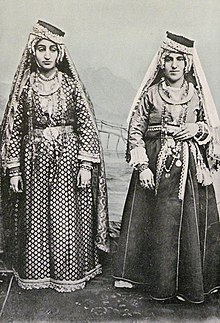
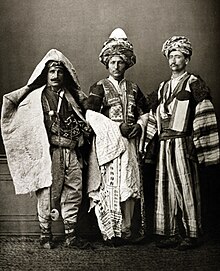


- 아르메니아인(Hayer):기독교 아르메니아인들은 현재의 터키 동부, 특히 반 호수와 아라라트의 성서 산 주변의 원래 주민들이었고 서부 아르메니아어를 사용했습니다.[citation needed]최대 1,500,000명이 사망한 아르메니아인 집단학살 이후, 원래 아르메니아인 주민의 수는 거의 존재하지 않으며, 그들은 이후 터키계와 쿠르드족으로 대체되었습니다.[citation needed]
- 이란 민족
- 동이란인
- 서이란인
- 카스피해/남카스피해인
- 길락스: 길란, 북이란, 남카스피해 연안, 엘부르즈 산맥[citation needed]
- Mazanderanis/Mazanis/Tabaris: Mazanderan, Tabaristan, 북부 이란, 남카스피해 연안[citation needed] 및 엘부르즈 산맥
- 이란 북서부 민족
- 노스웨스턴 1세
- 노스웨스턴 2세
- 이란 남서부 민족
- 페르시아어:이란, 아프가니스탄, 타지키스탄, 우즈베키스탄
- 라레스타니-걸프족
- 쿰자리스:오만[citation needed] 북부 무산담
- 루르바크티아리스
- 루르(루르):루리스탄, 이란 서부와 남서부, 자그로스 산맥[citation needed]
- 바흐티아르(Bakhtiaris):이란 남서부, 자그로스[citation needed] 주
- 타츠 (캅카스):아제르바이잔 공화국, 다게스탄 (러시아)[citation needed]
- 카스피해/남카스피해인
북아프리카


- 아프로아시아어족
- 하라틴:마그레브와 사하라 사막의 기원이 불분명한 토착 인구; 구성원들은 현재 베르베르어 또는 아랍어를 사용합니다; 모로코, 모리타니, 서사하라, 알제리에 거주합니다.
- 세레르 - 현재 습성 세네가, 감비아, 모리타니
- 투부: 차드
- 콥츠(Remen Kh ēmi/Remen K ēme):이집트 인구의 대다수가 고대 이집트인의 후손인 이집트.
- 베자: 수단 북동부, 홍해 연안과 나일강(흰 나일강과 푸른 나일강) 동부 은행, 에리트레아 북서쪽, 사하라 동부 사막, 이집트 남동쪽
- 시위 베르베르: 시와 오아시스(이시완), 이집트 서부, 사하라
- 관체스: 스페인 카나리아 제도
중앙아시아

- 인도유럽인
코카서스

- 인도유럽인
- 카트벨리아인
- 북동캅카스인
- 북서캅카스인
남아시아
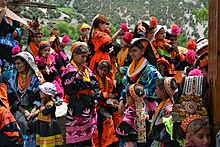



인도 아대륙
- 아디바시스(Adivasis): 인도의 여러 원주민을 통칭하는 말(인도의 예정 부족 참조)
- 부루쇼:파키스탄 북부 길기트발티스탄 훈자 치트랄 구
- 중티베트어족
- 베다(Wanniyala-Aetto):스리랑카
- 싱할라어:스리랑카
- 디베히: 몰디브
안다만니코바르 제도
동북아시아


중국
서중국
북중국
남중국
몽골
타이완
- 타이완 섬의 원주민들
일본
한국을
시베리아
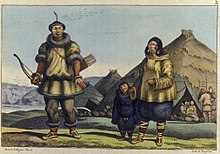


러시아의 아시아 지역(시베리아/북아시아)에 각각 고유의 언어와 문화를 가진 40개 이상의 다양한 민족.
- 축치캄차칸족
- 에스키모알류트족
- 몽골족
- 퉁구스어족
- 튀르크족
- 우그릭 족
- 사모예드족
- 유카히르(오둘/바둘/데킬'):극동 시베리아, 러시아
- 예니세족
- 니브크(길랴크):사할린, 러시아
- 오록스(Uilta):사할린, 러시아
동남아

동남아시아 본토 (인도차이나 반도)
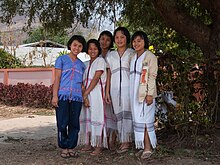
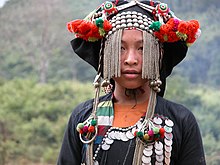
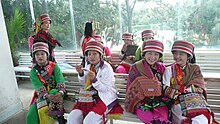

- 오스트로아시아족
- 오스트로네시아인
- 몽미엔족
- Montagnards (Degar): 베트남 남부 지역의 고원과 산에 사는 여러 선 베트남 민족들을 일컫는 우산 용어
- 네그리토:
- 중티베트어족
- 타이족:베트남, 미얀마, 라오스, 태국 (중국 윈난성에도 분포함).
동남아시아 연안 (말레이 군도)


- 오스트로네시아인
- 오랑 림바(오랑 배트인 셈빌란/오랑 림바/아낙 달람/쿠부):인도네시아 수마트라
- 루부: 인도네시아 수마트라
- 네그리토:
- 프리부미(인도네시아어족): 인도네시아어
유럽

어떤 자료들은 사미족을 유럽에서 유일하게 인정받는 토착 민족으로 묘사하고,[100][101][102] 다른 자료들은 그들을 유럽 연합의 유일한 토착 민족으로 묘사합니다.[103][104][105][106]1989년 원주민 및 부족민 협약에서 원주민을 설명하는 데 적합한 것으로 간주될 수 있는 다른 집단, 특히 중유럽, 서유럽 및 남유럽의 소르브족과 같은 집단은 일반적으로 국가적 소수 민족으로 분류됩니다.[107]
북유럽
동유럽
남유럽
서유럽
아메리카 대륙
아메리카 대륙은 북아메리카와 남아메리카 그리고 그와 연관된 섬들로 구성된 초대륙입니다.
지리학적 민족언어학적 분류에 따른 민족 목록:
북아메리카
북아메리카는 베링 해협 동쪽과 파나마 지협 북쪽의 모든 대륙과 섬을 포함하며, 그린란드, 캐나다, 미국, 멕시코, 중앙 아메리카, 카리브해 국가들을 포함합니다.그러나 민족적, 문화적 특성으로 인해 더 넓은 북미와 더 좁은 북미와 중간 아메리카 사이에 구분이 가능합니다.
북극성

- 고대 베링기안 - 시베리아와 알래스카
- 에스키모알류트 주
- 메티스(Métis): 캐나다의 여러 민족과 유럽의 여러 민족이 섞여 있습니다.
아북극
퍼시픽 노스웨스트코스트
- 미국 워싱턴의 마카.
- 미국 워싱턴의 퀴노.
- 캐나다 브리티시 콜롬비아의 누트카.
- 캐나다 브리티시컬럼비아주의 콰키우틀.
- 미국 알래스카의 에이악.
- 캐나다 브리티시컬럼비아주와 미국 알래스카주의 하이다.
- 미국 알래스카의 트링깃.
- 캐나다 브리티시컬럼비아주와 미국 알래스카주의 침시안.
북서부 고원-대분지-캘리포니아
북서부 고원
대분지
- Ute of Utah, 미국.
- 미국 네바다주 콜로라도와 유타주의 쇼숀.
- 미국 네바다주의 와슈.
- 콜로라도, 캘리포니아, 네바다, 그리고 미국 유타의 Paute.
- 미국 애리조나주 콜로라도와 뉴멕시코주 파이스, 멕시코 바하칼리포르니아.
캘리포니아
- 유먼코치미족
- 미국 캘리포니아의 미웍.
- 미국 캘리포니아의 마이두.
- 미국 캘리포니아의 윈투.
- 미국 캘리포니아의 추마시.
- 미국 캘리포니아의 통바.
- 캘리포니아와 미국 오리건주의 모독.
- 아바스칸스인
- 미국 캘리포니아의 카후일라.
- 캘리포니아의 모하비와 미국의 네바다.
- 오토아츠칸스
- 미국 캘리포니아의 카록.
대평원
- 미국 텍사스와 오클라호마의 코만치입니다.
- 캔자스와 네브라스카의 오세이지, 미국.
- 미국 노스다코타주, 사우스다코타주, 미네소타주, 서스캐처원주, 캐나다 앨버타주의 수.
- 텍사스의 키오와와 오클라호마.
- 몬태나의 까마귀.
- 네브라스카의 오마하.
- 미국 몬타나 주, 캐나다 앨버타 주, 그리고 캐나다 서스캐처원 주의 블랙풋.
이스턴우들랜즈
노스이스턴우들랜즈
- 이로쿼이족
- 미국의 뉴욕, 위스콘신, 오클라호마의 하우데노수니와 캐나다의 퀘벡, 온타리오.
- 미시간주 캔자스와 미국 오클라호마의 와이언도트와 캐나다 온타리오.
- 오하이오주 뉴욕 업스테이트와 미국 펜실베니아주 북서부의 네이션 두 채팅.
- 펜실베이니아, 웨스트버지니아, 뉴욕, 메릴랜드(미국)의 코네스토가(Susquehannock).
- 세인트 로렌스 이로쿼이안스: 세인트 로렌스 강, 캐나다 퀘벡, 그리고 미국 뉴욕.
- 모논가헬라: 펜실베니아, 웨스트 버지니아, 그리고 미국 오하이오.
- 미국 버지니아 주는 안 됩니다.
- 미국 버지니아주와 사우스캐롤라이나주의 웨스토.
- 알지크족
사우스이스턴우들랜즈
남서쪽
메소아메리카

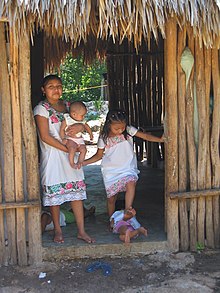


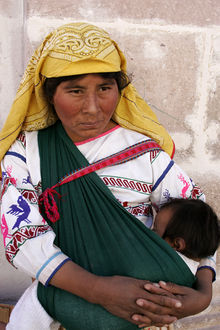
- Huave(Ikoots/Kunajts):오악사카, 멕시코
- 마야족
- 믹세조크족
- 오토망게족
- 타라스칸 (푸르헤페차):미초아칸 주
- Tequistlatecan/Chontal de Oaxaca: Oaxaca, 멕시코
- 토토나칸족
- 오토아즈테카족
중앙아메리카
중앙 아메리카는 일반적으로 테후안테펙 지협과 다리엔 갭 사이에 위치한 북아메리카의 하위 지역으로 정의됩니다.

메소아메리카
이스모콜롬비아 지역


- 치브찬족
- 초코/엠베라우나어족
- 미수말판족
- 톨루판/지카크:온두라스
- 잠보/카푸소족(서아프리카와 아메리카 인디언의 혼혈)
- 검은색 세미놀:플로리다, 바하마, 그리고 멕시코. (세미놀과 아프리카의 혼합)
남미

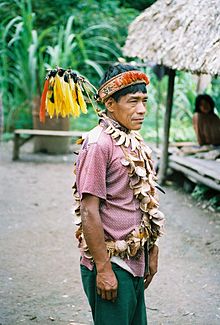
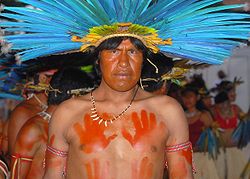

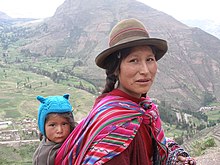
남아메리카는 일반적으로 파나마 지협 남쪽의 모든 대륙과 섬들을 포함합니다.
이스모콜롬비아 지역
아마존
- 아라와크족
- 바르바코족
- 아완
- 아와콰이커: 에콰도르 북부
- 아완
- 보라위토족
- 카와파난족
- 지바로안(Shuar):로레토 산마르틴 주
- 누카크: 콜롬비아
- 파노아인
- 피라항: 브라질
- 티쿠나유리족
- 투카노어족
- 투피아족
- 우라리나(카차):로레토 페루 참비라 분지
- 야노마미(얀 õ마미/얀 õ마미 Th ëp ë):베네수엘라/브라질
기아나스
동부 고원 (브라질 고원)
차코
중앙안데스
서던콘
아라우카니아
파타고니아
- 푸엘체:아르헨티나
- 초노: 칠레, 과이테카스, 초노스
- 테후엘체:칠레 남부/아르헨티나
- 알라칼루페 (카웨스카르):티에라 델 푸에고, 칠레
- 셀크남(오나):티에라 델 푸에고, 아르헨티나, 칠레
- 야한(야마나):티에라 델 푸에고, 칠레
- 하우쉬(마네켄크):티에라 델 푸에고, 아르헨티나
캐리비안

서인도 제도, 또는 카리브 제도는 일반적으로 카리브 해의 섬들, 즉 루카얀 군도, 대 앤틸리스 제도, 그리고 소 앤틸리스 제도를 포함합니다.
- 아라와크족
- 북부.
- 카리브족/타아라와크족
- 아이리/이그네리: 소앤틸리스.아라와크족은 카리브해화 이전의 칼리나고/섬 카리브족이었을지도 모릅니다.(아일랜드 카리브족은 이그네리족이 소앤틸레스의 더 나이 많은 사람들이라는 전통을 가지고 있었지만, 그들은 아일랜드 카리브족 대다수의 조상이었을 수도 있습니다.)
- 아일랜드 카리브 (카리브/칼리나고/칼리포나):소앤틸리스.흔히 "아일랜드 카리브"라고 불리지만, 순록 정복 전사 엘리트를 가진 오래된 아라와크족이거나 본토 카리브의 영향을 받았을 수도 있습니다.분명히, 대부분의 사람들은 순록이 아닌 아라와크어를 사용했습니다.
- 타이노(Taíno): 원래 카리브해의 대앤틸레스 제도에 살았던 아메리카 인디언들, 그들은 아라와크족 혈통입니다.
- 카리브족/타아라와크족
- 북부.
- 시과요:히스파니올라섬 동부
- 마코릭스: 히스파니올라
- 구아나하타베이:서쿠바
오세아니아
오세아니아는 태평양, 뉴기니, 뉴질랜드 그리고 오스트레일리아 대륙의 대부분의 섬을 포함합니다.
지리학적 민족언어학적 분류에 따른 민족 목록:
호주.

호주 원주민들은 본토와 티위 제도의 호주 원주민들과 토레스 해협 제도의 토레스 해협 섬 주민들을 포함합니다.
- 호주 원주민들은 수백 명의 사람들의 그룹을 포함하며, 하위 그룹을 포함할 수 있는 언어, 문화, 지리와 같은 다양한 중첩된 특성으로 정의됩니다.태즈메이니아 섬의 원주민과 티위족(북쪽 영토에서 떨어진 티위 제도의 원주민)도 토레스 해협 섬 사람들과 유전적으로 문화적으로 구분되는 원주민입니다.
- 토레스 해협 섬 주민들은 문화적, 언어적으로 파푸아오스트로네시아인이며, 이 섬의 다양한 민족들은 주로 멜라네시아 혈통입니다.토레스 해협 섬은 퀸즈랜드 주의 일부입니다.
서부사막
- 파마녕안족
- 쿠나파: 노던 준주, 오스트레일리아
- 피니: 웨스턴 오스트레일리아, 오스트레일리아
- 스피니펙스: 웨스턴 오스트레일리아, 오스트레일리아
- 왕카타(Wangkatha):
- 와루문구:노던 준주
- 와티족
- Yankuntjatjara: 사우스 오스트레일리아, 오스트레일리아
- 민디족
킴벌리
- 부누반족
- 자라칸족
- 늘률란족
- 늘눌라족
- 바르디: 다피어 반도, 웨스턴 오스트레일리아, 오스트레일리아
- Jabirr Jabirr: 담피어 반도, 웨스턴 오스트레일리아, 오스트레일리아
- 자위: 더피어 반도, 웨스턴 오스트레일리아, 오스트레일리아
- 니만부루: 다피어 반도, 웨스턴 오스트레일리아, 오스트레일리아
- 느율: 담피에 반도, 웨스턴 오스트레일리아, 오스트레일리아
- 유쿤족
- 주군: 다피어 반도, 웨스턴 오스트레일리아, 오스트레일리아
- 응곰발:더피어 반도, 웨스턴오스트레일리아, 오스트레일리아
- 니기나: 더피어 반도, 웨스턴 오스트레일리아, 오스트레일리아
- 워와(Warrwa): 담피어 반도(Dampier Peninsula), 웨스턴 오스트레일리아, 오스트레일리아
- 야우루: 담피에 반도, 웨스턴 오스트레일리아, 오스트레일리아
- 늘눌라족
- 워러런족
북서쪽
- 파마녕안족
- 은가야르다족
- Bailgu: 필바라 지역, 웨스턴 오스트레일리아, 오스트레일리아
- 이나웡가:필바라 지역, 웨스턴오스트레일리아, 오스트레일리아
- 자디라(Jadira): 필바라(Pilbara) 지역, 웨스턴 오스트레일리아, 오스트레일리아
- 쿠라마: 필바라 지역, 웨스턴 오스트레일리아, 오스트레일리아
- 마르두두네라(Mardudunera): 필바라(Pilbara) 지역, 웨스턴 오스트레일리아, 오스트레일리아
- 응갈라(Ngarla): 필바라(Pilbara) 지역, 웨스턴 오스트레일리아, 오스트레일리아
- 응갈루마: 필바라 지역, 웨스턴오스트레일리아, 오스트레일리아
- 니아발리: 필바라 지역, 웨스턴오스트레일리아, 오스트레일리아
- 누왈라(Nhuwala): 필바라(Pilbara) 지역, 웨스턴 오스트레일리아, 오스트레일리아
- Nyamal: 필바라 지역, 웨스턴 오스트레일리아, 오스트레일리아
- 파니지마:필바라 지역, 웨스턴오스트레일리아, 오스트레일리아
- Tjuroro: 필바라 지역, 웨스턴 오스트레일리아, 오스트레일리아
- 칸야라만타르타족
- 칸야라족
- 바이운구:가스코인 지역, 웨스턴오스트레일리아, 오스트레일리아
- 비니구라(Binigura): 필바라(Pilbara) 지역, 웨스턴 오스트레일리아, 오스트레일리아
- 부루나(Buruna): 중서부 지역, 웨스턴 오스트레일리아, 오스트레일리아
- 탈라니지: 필바라 지역, 웨스턴오스트레일리아, 오스트레일리아
- Yinikutira: Exmouth, Western Australia
- 만타르타족
- Djiwali: 필바라 지역, 웨스턴 오스트레일리아, 오스트레일리아
- Tharkari: 가스코인 지역, 웨스턴 오스트레일리아, 오스트레일리아
- 텐마: 필바라 지역, 웨스턴오스트레일리아, 오스트레일리아
- 워리양가:가스코인 지역, 웨스턴오스트레일리아, 오스트레일리아
- 칸야라족
- 카르투족
- 은가야르다족
남서쪽
- 파마녕안족
- ung기족
- 눙가르족
- Amangu: Geraldton Sandplains, 웨스턴 오스트레일리아, 오스트레일리아
- 발라동:에이본 휘트벨트, 웨스턴오스트레일리아, 오스트레일리아
- Yueed: 호주 서부, 스완 해안 평원
- 카네앙: 재라 숲, 웨스턴 오스트레일리아, 오스트레일리아
- 코랭: 말리, 웨스턴오스트레일리아, 오스트레일리아
- Mineng: Warren, 웨스턴 오스트레일리아, 오스트레일리아
- 냐킨자키:에이본 휘트벨트, 웨스턴오스트레일리아, 오스트레일리아
- 은중가: 호주 서호주 에스페란스 평원
- 비불만:워렌, 웨스턴오스트레일리아, 오스트레일리아
- 핀드자루프: 재라 숲, 웨스턴 오스트레일리아, 오스트레일리아
- Wardandi: 호주 서부, 스완 해안 평원
- 화죽: 재라 숲, 웨스턴 오스트레일리아, 오스트레일리아
- 와일만:웨스턴오스트레일리아, 오스트레일리아
- 우드자리: 말리, 웨스턴오스트레일리아, 오스트레일리아
- 칼라코: 골드필즈 – 에스퍼런스 지역, 웨스턴오스트레일리아, 오스트레일리아
- 칼라마이아:웨스턴오스트레일리아, 오스트레일리아
- 미링족
- 미링:웨스턴오스트레일리아, 사우스오스트레일리아, 오스트레일리아
- 응아드주마야:골드필즈 – 호주 서호주 에스퍼런스 지역
- 잉카르타: 가스코인 지역, 웨스턴 오스트레일리아, 오스트레일리아
- 눙가르족
- ung기족
피츠모리스 분지
아른헴랜드
상단
걸프국
케이프요크
웨스트케이프
- 파마녕안족
- 파만족
- 노스케이프 요크파만족
- 파만족
이스트케이프
다인트리 열대우림
에어 호수 분지
스펜서 만
- 파마녕안족
- 튀라유라족
- 위랑구:사우스오스트레일리아주
- 나우오: 에어 반도, 사우스 오스트레일리아, 오스트레일리아
- 반갈라:에어 반도, 사우스오스트레일리아, 오스트레일리아
- 쿠야니(Kuyani):
- Adnyamathanha: Flinders Ranges, South Australia, Australia
- 말양아파:뉴사우스웨일스주, 뉴사우스웨일스 주
- 응아주리:사우스오스트레일리아주
- 누쿠누: 사우스오스트레일리아, 오스트레일리아
- 나룽가:요크 반도, 사우스오스트레일리아, 오스트레일리아
- 카우나: 애들레이드 평원, 사우스 오스트레일리아, 오스트레일리아
- Peramangk:애들레이드 평원, 사우스오스트레일리아, 오스트레일리아
- 튀라유라족
머레이달링 분지
- 파마녕안족
동북쪽
남동쪽
태즈메이니아 주
- 팔라와족
토레스 해협 제도
멜라네시아
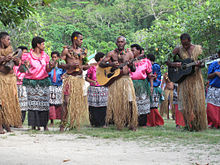
멜라네시아는 일반적으로 뉴기니와 아라푸라해에서 피지에 이르는 서태평양의 다른 섬들을 포함합니다.이 지역에는 멜라네시아인들이 대부분 거주하고 있습니다.
- 멜라네시아인
- 파푸아인: 각각 고유의 언어와 문화를 가진 250개 이상의 다른 부족 또는 씨족.뉴기니의 주요 섬과 주변 섬들(파푸아뉴기니(PNG)와 인도네시아의 서파푸아 주와 파푸아 주를 형성하는 영토)."원주민"으로 여겨지는 이 사람들은 많은 논쟁의 대상입니다.
미크로네시아
미크로네시아는 일반적으로 서부와 중부 태평양의 다양한 작은 섬들을 포함합니다.이 지역에는 미크로네시아인들이 대부분 거주하고 있습니다.
폴리네시아
이 기사는 검증을 위해 추가적인 인용이 필요합니다. 찾기 : – · · 책 · (2021년 12월)(이 를 및 |

폴리네시아는 뉴질랜드와 오세아니아의 섬을 포함하며 다양한 원주민 인구를 가지고 있습니다.[113]
폴리네시아인
- 하와이 원주민[114]
- 통가인[114]
- 투발루아인
- 마르케사스 섬 주민
- 라파누이
- 사모안스
- 토켈라우
- 오스트레일리아 섬 주민
- 쿡 아일랜더스
- 마오히, 타히티
- 마오리
- 채텀 제도의 모리오리
- 타히티인, 프랑스령 폴리네시아
- 투아모투스속
- 니우에족
폴리네시아 이상점
- 바누아인[주1]
- 미크로네시아 연방 카핑마랑이와 누쿠오로
- 솔로몬 제도의 렌넬, 티코피아, 바에아카우타우마코
- 누구리아 주, 파푸아뉴기니
- 누쿠마누, 파푸아뉴기니
- 파푸아뉴기니 타쿠우
- 온통 자바
- 스키아나
- 솔로몬 제도 아누타
- 파가우베아 주, 우베아 주, 뉴칼레도니아
- 아니와
- 벨로나
- 렌넬
극지
극지방 사람들은 북극의 다양한 토착민들의 우산 용어입니다.
민족언어학적 분류에 따른 민족 목록:
- 팔레오시베리아인
- 에스키모알류트 주
- 튀르크어의
- 우크라이나, 유고슬라비아, 시베리아, 러시아
- 이전에 랩스라는 별칭으로 알려진 사미(사미/사미/랍): 북부 노르웨이, 스웨덴, 핀란드, 러시아의 콜라 반도
- 사모예드족
- 유카히르(오둘/바둘/데킬'):극동 시베리아, 러시아
참고 항목
- 세계원주민연구센터
- 원주민의 권리에 관한 선언
- 원주민
- 토착 고고학
- 원주민 대화체
- 원주민 (생태학)
- 원주민 지식재산권
- 토착지식
- 토착어
- 토착의학
- 토속음악
- 원주민문제 국제작업반
- 국제 연합 원주민 문제 상설 포럼
- 세계원주민협의회
- 원주민 인구 워킹 그룹
- 동시대의 민족 목록
- 국적별 인물 목록
- 원주민 권리 단체 목록
- 시작하는 모든 페이지 보기 토착민 아니면 토착의
참고문헌
메모들
인용문
- ^ "Indigenous Peoples and the United Nations Human Rights System" (PDF). United Nations. p. 7. Retrieved 21 May 2023.
- ^ a b c McIntosh, Ian (September 2000). "Are there Indigenous Peoples in Asia?". Cultural Survival Quarterly Magazine. Archived from the original on 22 April 2021. Retrieved 1 April 2021.
- ^ United Nations Permanent Forum on Indigenous Issues. Who are indigenous peoples? (PDF) (Report). Archived (PDF) from the original on 2023-05-25.
- ^ Mathewson, Kent (2004). "Drugs, Moral Geographies, and Indigenous Peoples: Some Initial Mappings and Central Issues". Dangerous Harvest: Drug Plants and the Transformation of Indigenous Landscapes. Oxford University Press. p. 13. ISBN 978-0-19-514319-5.
As Sir Thomas Browne remarked in 1646, (this seems to be the first usage in its modern sense).
- ^ Browne, Sir Thomas (1646). "Pseudodoxia Epidemica, Chap. X. Of the Blackness of Negroes". University of Chicago. Archived from the original on 15 March 2023. Retrieved 3 March 2021.
- ^ "Who are the indigenous and tribal peoples?". www.ilo.org. 22 July 2016. Archived from the original on 2 May 2019. Retrieved 2 May 2019.
- ^ 아차리야, 디팍, 슈리바스타바 안슈(2008):토종 한약재:부족 제형과 전통 약초 관행, Aavishkar Publishers Distributor, Jaipur, India.ISBN 978-81-7910-252-7. 페이지 440
- ^ LaDuke, Winona (1997). "Voices from White Earth: Gaa-waabaabiganikaag". People, Land, and Community: Collected E.F. Schumacher Society Lectures. Yale University Press. pp. 24–25. ISBN 978-0-300-07173-3.
- ^ Miller, Robert J.; Ruru, Jacinta; Behrendt, Larissa; Lindberg, Tracey (2010). Discovering Indigenous Lands: The Doctrine of Discovery in the English Colonies. OUP Oxford. pp. 9–13. ISBN 978-0-19-957981-5.
- ^ Taylor Saito, Natsu (2020). "Unsettling Narratives". Settler Colonialism, Race, and the Law: Why Structural Racism Persist (eBook). NYU Press. ISBN 978-0-8147-0802-6. Archived from the original on 15 March 2023. Retrieved 21 December 2020.
...several thousand nations have been arbitrarly (and generally involuntarily) incorporated into approximately two hundred political constructs we call independent states...
- ^ Sanders, Douglas (1999). "Indigenous peoples: Issues of definition". International Journal of Cultural Property. 8: 4–13. doi:10.1017/S0940739199770591. S2CID 154898887.
- ^ 보들리 2008:2
- ^ Muckle, >:>Robert J. (2012). Indigenous Peoples of North America: A Concise Anthropological Overview. University of Toronto Press. p. 18. ISBN 978-1-4426-0416-2.
- ^ McIntosh, Ian (September 2000). "Are there Indigenous Peoples in Asia?". Cultural Survival Quarterly Magazine. Archived from the original on 22 April 2021. Retrieved 1 April 2021.
Looking specifically at Asia ... we see a blanket denial by the power structure of the existence of first peoples, and/or of the idea that any group deserves special treatment because of the specificities of their culture.
- ^ McIntosh, Ian (September 2000). "Are there Indigenous Peoples in Asia?". Cultural Survival Quarterly Magazine. Archived from the original on 22 April 2021. Retrieved 1 April 2021.
the word itself now has little meaning outside of the struggle for rights and dignity on the part of minorities and the oppressed.
- ^ Grote, Rainer (2006). "On the Fringes of Europe: Europe's Largely Forgotten Indigenous Peoples". American Indian Law Review. 31 (2): 425–443. doi:10.2307/20070794. JSTOR 20070794.
- ^ 호세 R. 마르티네스 코보
- ^ 토착민의 정의
- ^ Hakansson, N. Thomas (1994). "The Detachability of Women: Gender and Kinship in Processes of Socioeconomic Change among the Gusii of Kenya". American Ethnologist. 21 (3): 516–538. doi:10.1525/ae.1994.21.3.02a00040. JSTOR 645919.
- ^ Maxon, R.M. (1976). "Gusii Oral Texts and the Gusii Experience under British Rule". The International Journal of African Historical Studies. 9 (1): 74–80. doi:10.2307/217392. JSTOR 217392.
- ^ Snyder, Katherine A. (2006). "Mothers on the March: Iraqw Women Negotiating the Public Sphere in Tanzania". Africa Today. 53 (1): 79–99. doi:10.1353/at.2006.0064. JSTOR 4187757. S2CID 144707308.
- ^ Boone, Catherine; Nyeme, Lydia (2015). "Land Institutions and Political Ethnicity in Africa: Evidence from Tanzania". Comparative Politics. 48 (1): 67–86. doi:10.5129/001041515816075123. JSTOR 43664170.
- ^ a b Boone, Catherine (2012). "Land Conflict and Distributive Politics in Kenya". African Studies Review. 55 (1): 75–103. doi:10.1353/arw.2012.0010. hdl:2152/19778. JSTOR 41804129. S2CID 154334560.
- ^ Jungerius, P. D. (1998). "Indigenous knowledge of landscape-ecological zones among traditional herbalists: a case study in Keiyo District, Kenya". GeoJournal. 44 (1): 51–60. doi:10.1023/A:1006851813051. JSTOR 41147169. S2CID 128857738.
- ^ McGlashan, Neil (1964). "Indigenous Kikuyu Education". African Affairs. 63 (250): 47–57. doi:10.1093/oxfordjournals.afraf.a095163. JSTOR 719766.
- ^ Castro, Alfonso Peter (1991). "Indigenous Kikuyu Agroforestry: A Case Study of Kirinyaga, Kenya". Human Ecology. 19 (1): 1–18. doi:10.1007/BF00888974. JSTOR 4602996. S2CID 154663699.
- ^ Kubow, Patricia K. (2007). "Teachers' Constructions of Democracy: Intersections of Western and Indigenous Knowledge in South Africa and Kenya". Comparative Education Review. 51 (3): 307–328. doi:10.1086/518479. JSTOR 10.1086/518479. S2CID 145758842.
- ^ Crowley, Eve L.; Carter, Simon E. (2000). "Agrarian Change and the Changing Relationships between Toil and Soil in Maragoli, Western Kenya (1900-1994)". Human Ecology. 28 (3): 383–414. doi:10.1023/A:1007005514841. JSTOR 4603359. S2CID 146217282.
- ^ Hodgson, Dorothy (2011). Being Maasai, Becoming Indigenous: Postcolonial Politics in a Neoliberal World. Indiana University Press. ISBN 9780253223050.
- ^ Shani, Serah (2022). Indigenous Elites in Africa: The Case of Kenya's Maasai. Routledge, Taylor & Francis. ISBN 9781032025766.
- ^ "토종 마사이족은 고향 마을에서 농사를 지을 땅을 확보하고 싶어했습니다." (29쪽)
- ^ Sifuna, Daniel (1984). "Indigenous Education in Nomadic Communities : A Survey of The Samburu, Rendille, Gabra and Boran of Northern Kenya". Présence Africaine Nouvelle. 131 (3e): 66–88. doi:10.3917/presa.131.0066. JSTOR 24350929.
- ^ Campbell, John R. (2004). "Ethnic minorities and development: A prospective look at the situation of African pastoralists and hunter-gatherers". Ethnicities. 4 (1): 5–26. doi:10.1177/1468796804040326. JSTOR 23890130. S2CID 145416864.
- ^ Holtzman, Jon D. (2003). "In a Cup of Tea: Commodities and History among Samburu Pastoralists in Northern Kenya". American Ethnologist. 30 (1): 136–155. doi:10.1525/ae.2003.30.1.136. JSTOR 3805213.
- ^ "Eritrean Afar People". Eritrean Afar National Congress. Archived from the original on 2022-01-04. Retrieved 2022-01-04.
- ^ Danver 2015, p. 601-603,610.(
- ^ Beall, Cynthia M. (2014). "Adaptation to High Altitude: Phenotypes and Genotypes". Annual Review of Anthropology. 43: 251–272. doi:10.1146/annurev-anthro-102313-030000. JSTOR 43049574.
- ^ Young, John (1999). "Along Ethiopia's Western Frontier: Gambella and Benishangul in Transition". The Journal of Modern African Studies. 37 (2): 321–346. doi:10.1017/S0022278X9900302X. JSTOR 161849. S2CID 155057210.
- ^ Sanches, Edalina Rodrigues (2022). Popular Protest, Political Opportunities, and Change in Africa. Routledge. pp. 181–2. doi:10.4324/9781003177371-11. ISBN 9781003177371. S2CID 246711828.
...recognition of the identity of indigenous Amhara people from Welkait as Amhara
- ^ John, Sonja (2021-09-13). "Civil rights activists in Welkait give hope for peace and democracy in Ethiopia". Africa at LSE. Retrieved 2022-02-20.
They requested state institutions recognise their indigenous Amhara identity and end discrimination.
- ^ Donham, Donald L. (1992). "Revolution and Modernity in Maale: Ethiopia, 1974 to 1987". Comparative Studies in Society and History. 34 (1): 28–57. doi:10.1017/S0010417500017424. JSTOR 178984. S2CID 143440554.
- ^ Lydall, Jean (2000). "The Threat of the HIV/AIDS Epidemic in South Omo Zone, Southern Ethiopia". Northeast African Studies. Special Issue: HIV/AIDS in Ethiopia, Part I: Risk and Preventive Behavior, Sexuality, and Opportunistic Infections. 7 (1): 41–61. doi:10.1353/nas.2004.0007. JSTOR 41931329. S2CID 143405452.
- ^ Azeze, Fekade (2001). "The State of Oral Literature Research in Ethiopia: Retrospect and Prospect". Journal of Ethiopian Studies. 34 (1): 43–85. JSTOR 41966115.
- ^ Jedrej, M. C. (1975). "Ingessana Throwing Knives (Sudan)". Anthropos. Bd. 70, H. 1./2. 70 (1/2): 42–48. JSTOR 40458698.
- ^ Jedrej, M. C. (2004). "The Southern Funj of the Sudan as a Frontier Society, 1820-1980". Comparative Studies in Society and History. 46 (4): 709–729. doi:10.1017/S0010417504000337. JSTOR 3879507. S2CID 145732712.
- ^ Amborn, Hermann; Schubert, Ruth (2006). "The Contemporary Significance of What Has Been. Three Approaches to Remembering the past: Lineage, Gada, and Oral Tradition". History in Africa. 33: 53–84. doi:10.1353/hia.2006.0004. JSTOR 20065765. S2CID 162724953.
- ^ a b Debelo, Asebe Regassa; Jirata, Tadesse Jaleta (2018). ""Peace Is Not a Free Gift": Indigenous Conceptions of Peace among the Guji-Oromo in Southern Ethiopia". Northeast African Studies. 18 (1–2): 201–230. doi:10.14321/nortafristud.18.1-2.0201. JSTOR 10.14321/nortafristud.18.1-2.0201.
- ^ Merid, Takele (2019). "Indigenous Ecological Knowledge and the Changing Livelihood Strategies of the Gedeo People". Journal of Ethiopian Studies. 52: 139–166. JSTOR 48619998.
- ^ Donovan, Dolores A.; Assefa, Getachew (2003). "Homicide in Ethiopia: Human Rights, Federalism, and Legal Pluralism". The American Journal of Comparative Law. 51 (3): 505–552. doi:10.2307/3649118. JSTOR 3649118.
- ^ Meckelburg, Alexander (2015). "Slavery, Emancipation, and Memory: Exploratory Notes on Western Ethiopia". The International Journal of African Historical Studies. Special Issue: Exploring Post-Slavery in Contemporary Africa. 48 (2): 345–362. JSTOR 44723364.
- ^ a b c Fratkin, Elliot (2014). "Ethiopia's Pastoralist Policies: Development, Displacement and Resettlement". Nomadic Peoples. Special issue: The Emerging World of Pastoralists and Nomads. 18 (1): 94–114. doi:10.3197/np.2014.180107. JSTOR 43124163. S2CID 147312991.
- ^ Strecker, Ivo (2007). "A Hamar Spokesman on German Television and Radio: lessons on cultural difference and similarity". Journal of Ethiopian Studies. 40 (1/2): 181–201. JSTOR 41988226.
- ^ a b Pankhurst, Alula (2002). "Research on Ethiopian societies and cultures during the second half of the twentieth century". Journal of Ethiopian Studies. 35 (2): 1–60. JSTOR 41966134.
- ^ a b Jalata, Asafa (2017). "The Oromo Movement: The Effects of State Terrorism and Globalization in Oromia and Ethiopia". Social Justice. 44 (4): 83–106. JSTOR 26538396.
- ^ a b Naty, Alexander (2002). "Environment, Society and the State in Western Eritrea". Africa: Journal of the International African Institute. 72 (4): 569–597. doi:10.3366/afr.2002.72.4.569. JSTOR 3556702. S2CID 142770729.
- ^ a b Woldemikael, Tekle M. (2003). "Language, Education, and Public Policy in Eritrea". African Studies Review. 46 (1): 117–136. doi:10.2307/1514983. JSTOR 1514983. S2CID 143172927.
- ^ Donham, Donald L. (1992). "Revolution and Modernity in Maale: Ethiopia, 1974 to 1987". Comparative Studies in Society and History. 34 (1): 28–57. doi:10.1017/S0010417500017424. JSTOR 178984. S2CID 143440554.
- ^ Donham, Donald L. (2000). "On Being "First": Making History by Two's in Southern Ethiopia". Northeast African Studies. Special Issue: Cultural Variation and Social Change in Southern Ethiopia: Comparative Approaches. 7 (3): 21–33. doi:10.1353/nas.2005.0005. JSTOR 41931255. S2CID 144593095.
- ^ Turton, David (1992). ""We Must Teach Them to Be Peaceful": Mursi views on being human and being Mursi". Nomadic Peoples. 31 (31): 19–33. JSTOR 43123371.
- ^ Weldehaimanot, Simon M; Mekonnen, Daniel R (2012). "Favourable Awards to Trans-Boundary Indigenous Peoples". Australian Indigenous Law Review. 16 (1): 60–76. JSTOR 26423239.
- ^ Tewolde, Azeb (2018). "The Archives of Eritrea as a Primary Source of Information for the Eritrean Cultural Heritage: Its Nature and Accessibility". Rassegna di Studi Etiopici. 3a Serie. 2 (49): 11–22. JSTOR 48564342.
- ^ Bender, M. L. (1971). "The Languages of Ethiopia: A New Lexicostatistic Classification and Some Problems of Diffusion". Anthropological Linguistics. 13 (5): 165–288. JSTOR 30029540.
- ^ Quinlan, Marsha B.; Quinlan, Robert J.; Dira, Samuel Jilo (2014). "Sidama Agro-Pastoralism and Ethnobiological Classification of its Primary Plant, Enset (Ensete ventricosum)". Ethnobiology Letters. 5: 116–125. doi:10.14237/ebl.5.2014.222. JSTOR 26423590.
- ^ Hamer, John H. (2002). "The Religious Conversion Process among the Sidāma of North-East Africa". Africa: Journal of the International African Institute. 72 (4): 598–627. doi:10.3366/afr.2002.72.4.598. JSTOR 3556703. S2CID 143489496.
- ^ William T. W., Morgan (2000). "The Ethnic Geography of Kenya on the Eve of Independence: The 1962 Census (Ethnogeographie Kenias am Vorabend der Unabhängigkeit: Der Zensus von 1962)". Erdkunde. 54 (1): 76–87. doi:10.3112/erdkunde.2000.01.07. JSTOR 25647252.
- ^ Bouh, Ahmed Mohammed; Mammo, Yared (2008). "Indigenous Conflict Management and Resolution Mechanisms on Rangelands in Somali Regional State, Ethiopia". Nomadic Peoples. 12 (1): 109–121. doi:10.3167/np.2008.120107. JSTOR 43123815.
- ^ "Ethiopian Tribeswomen Seek to Attract Favourable Husbands With Lip Plates". Al Bawaba. 2020-06-24. Retrieved 2022-02-15.
- ^ a b Abbink, J. (2000). "Violence and the Crisis of Conciliation: Suri, Dizi and the State in South-West Ethiopia". Africa: Journal of the International African Institute. 70 (4): 527–550. doi:10.3366/afr.2000.70.4.527. hdl:1887/9482. JSTOR 1161471. S2CID 145471725.
- ^ Rahmato, Dessalegn (1995). "Resilience and Vulnerability: Enset Agriculture in Southern Ethiopia". Journal of Ethiopian Studies. 28 (1): 23–51. JSTOR 41966054.
- ^ International Crisis Group (2009-09-04). "V. Contested Multi-Ethnic Politics". Ethiopia: Ethnic Federalism and Its Discontents. pp. Page 22–Page 28.
{{cite book}}:journal=무시됨(도움말) - ^ Habtu, Alem (2005). "Multiethnic Federalism in Ethiopia: A Study of the Secession Clause in the Constitution". Publius. 35 (5): 313–335. doi:10.1093/publius/pji016. JSTOR 4624714.
- ^ 미대표 국가 및 인민기구 UNPO, 이라크 토착민 아시리아 [1]
- ^ Sawahla & Drolomy (2007, 페이지 425-433)
- ^ Williams, Victoria R. (2020-02-24). Indigenous Peoples: An Encyclopedia of Culture, History, and Threats to Survival [4 volumes]. ABC-CLIO. ISBN 978-1-4408-6118-5.
- ^ Tubb, 1998년 13-14페이지
- ^ 마크 스미스(Mark Smith)는 고대 이스라엘의 신 야훼와 다른 신들의 초기 역사(The Early History of God: Yahweh and Other Gods of Angient Israel)에서 "가나안 사람들과 이스라엘 사람들이 근본적으로 다른 문화를 가진 사람들이라는 오랜 포기 모델에도 불구하고, 고고학적 자료는 이제 이 견해에 의문을 제기합니다.제1철기(기원전 1200년경-1000년경)에는 팔레스타인인과 가나안인 사이에 다양한 공통점이 존재하는 지역의 물질문화.기록에 의하면 이스라엘 문화는 가나안 문화와 크게 겹치고 유래되었다고 합니다.간단히 말해서, 이스라엘 문화는 본질적으로 가나안 민족이 대다수가 가나안 민족이었습니다.제1철기에 가나안인과 팔레스타인인 사이의 급격한 문화적 격차는 정보가 있는 상황에서 유지될 수 없습니다."(6~7쪽)Smith, Mark (2002) 신의 초기 역사: 야훼와 고대 이스라엘의 다른 신들 (Eerdman's)
- ^ 렌츠버그, 게리 (2008)."성경 없는 이스라엘"프레더릭 E. 그린스판에서.히브리어 성경: 새로운 통찰력과 장학금.NYU 프레스, 페이지 3-5
- ^ 에리히 그루엔, 디아스포라: 그리스인과 로마인 속의 유대인 하버드 대학 출판부, 2009 페이지 3-4, 233-34: '강제적 탈구,… 디아스포라의 일부 이상을 설명할 수 없습니다.… 제2성전 시기에 해외에 거주하던 수많은 유대인들이 자발적으로 그렇게 했습니다.' (2)' 디아스포라는 로마의 힘과 파괴에 예루살렘이 무너지는 것을 기다리지 않았습니다.유대인들의 산란은 강제 추방을 통해 훨씬 이전부터, 자발적인 이주를 통해 훨씬 더 자주 시작되었습니다.'
- ^ 요셉푸스.유대인들의 전쟁 9:2
- ^ "Jewish Genetics - DNA, genes, Jews, Ashkenazi".
- ^ Haber, Marc; Gauguier, Dominique; Youhanna, Sonia; Patterson, Nick; Moorjani, Priya; Botigué, Laura R; Platt, Daniel E; Matisoo-Smith, Elizabeth; Soria-Hernanz, David F; Wells, R. Spencer; Bertranpetit, Jaume; Tyler-Smith, Chris; Comas, David; Zalloua, Pierre A (2013). "Genome-Wide Diversity in the Levant Reveals Recent Structuring by Culture". PLOS Genetics. 9 (2): e1003316. doi:10.1371/journal.pgen.1003316. PMC 3585000. PMID 23468648.
- ^ Behar, Doron M.; Yunusbayev, Bayazit; Metspalu, Mait; Metspalu, Ene; Rosset, Saharon; Parik, Jüri; Rootsi, Siiri; Chaubey, Gyaneshwer; Kutuev, Ildus; Yudkovsky, Guennady; Khusnutdinova, Elza K.; Balanovsky, Oleg; Semino, Ornella; Pereira, Luisa; Comas, David; Gurwitz, David; Bonne-Tamir, Batsheva; Parfitt, Tudor; Hammer, Michael F.; Skorecki, Karl; Villems, Richard (2010). "The genome-wide structure of the Jewish people". Nature. 466 (7303): 238–242. Bibcode:2010Natur.466..238B. doi:10.1038/nature09103. PMID 20531471. S2CID 4307824.
- ^ "Tracing the Roots of Jewishness". 2010-06-03.
- ^ Busbridge, Rachel (1 January 2018). "Israel-Palestine and the Settler Colonial 'Turn': From Interpretation to Decolonization". Theory, Culture & Society. 35 (1): 91–115. doi:10.1177/0263276416688544. ISSN 0263-2764. S2CID 151793639.
- ^ Ukashi, Ran (1 May 2018). "Zionism, Imperialism, and Indigeneity in Israel/Palestine: A Critical Analysis". Peace and Conflict Studies. 25 (1). doi:10.46743/1082-7307/2018.1442. ISSN 1082-7307.
- ^ Goldberg, Carole (14 April 2020). "Invoking the Indigenous, for and against Israel". Swimming against the Current. Academic Studies Press. pp. 298–318. doi:10.1515/9781644693087-019. ISBN 978-1-64469-308-7. S2CID 243669197.
- ^ Troen, Ilan; Troen, Carol (2019). "Indigeneity". Israel Studies. 24 (2): 17–32. doi:10.2979/israelstudies.24.2.02. ISSN 1084-9513. JSTOR 10.2979/israelstudies.24.2.02. S2CID 239062214.
- ^ Kattan, Victor. "'Invented' Palestinians, 'Indigenous' Jews: The Roots of Israel's Annexation Plan, and Why the World Must Stop Netanyahu, Before It's Too Late". Haaretz.
- ^ Pappe, Ilan (1 January 2018). "Indigeneity as Cultural Resistance: Notes on the Palestinian Struggle within Twenty-First-Century Israel". South Atlantic Quarterly. 117 (1): 157–178. doi:10.1215/00382876-4282082. hdl:10871/28176. ISSN 0038-2876.
- ^ Frantzman, Seth J.; Yahel, Havatzelet; Kark, Ruth (2012). "Contested Indigeneity: The Development of an Indigenous Discourse on the Bedouin of the Negev, Israel". Israel Studies. 17 (1): 78–104. doi:10.2979/israelstudies.17.1.78. ISSN 1527-201X. S2CID 143785060.
- ^ Yiftachel, Oren; Roded, Batya; Kedar, Alexandre (Sandy) (1 November 2016). "Between rights and denials: Bedouin indigeneity in the Negev/Naqab". Environment and Planning A: Economy and Space. 48 (11): 2129–2161. doi:10.1177/0308518X16653404. ISSN 0308-518X. S2CID 147970455.
- ^ Tatour, Lana (26 November 2019). "The culturalisation of indigeneity: the Palestinian-Bedouin of the Naqab and indigenous rights". The International Journal of Human Rights. 23 (10): 1569–1593. doi:10.1080/13642987.2019.1609454. ISSN 1364-2987. S2CID 150663547.
- ^ 유엔난민기구 UNHCR, 세계 소수민족과 토착민 명부 [2]
- ^ 타르투 에스토니아 대학 진화생물학과 Y-염색체 및 미토콘드리아 DNA 염기서열 변이로부터 사마리아인 및 기타 이스라엘 인구의 모계와 모계의 재구성, 분자인류학 그룹 [3]
- ^ Szczśniak, Andrew L. (1963). "A Brief Index of Indigenous Peoples and Languages of Asiatic Russia". Anthropological Linguistics. 5 (6): 1–29. ISSN 0003-5483. JSTOR 30022425.
- ^ "Orang Asli in Peninsular Malaysia : Population, Spatial Distribution and Socio-Economic Condition" (PDF).
- ^ "세계 소수 민족 및 토착민 목록 – 필리핀: 개요, 2007", UNHCR Refworld.
- ^ Hanihara, T (1992). "Negritos, Australian Aborigines, and the proto-sundadont dental pattern: The basic populations in East Asia". American Journal of Physical Anthropology. 88 (2): 183–96. doi:10.1002/ajpa.1330880206. PMID 1605316.
- ^ Agpaoa, Joshua C. (2013). Design Motifs of the Northern Philippine Textiles.
- ^ Baer, Lars-Anders (2005). "The Rights of Indigenous Peoples – A Brief Introduction in the Context of the Sámi". International Journal on Minority and Group Rights. 12 (2/3): 245–267. JSTOR 24675300.
- ^ Gouverneur, Cédric (1 January 2017). "Europe's only indigenous people". Le Monde Diplomatique. Retrieved 28 August 2023.
- ^ "Europe's only recognized indigenous peoples live in Sweden". Swedish Development Forum. 27 March 2018. Retrieved 28 August 2023.
- ^ "The Sámi: The People, Their Culture and Languages". Council of Europe. 2015. Retrieved 28 August 2023.
- ^ "Rights of the Sámi People". Finnish Ministry of Justice. Retrieved 28 August 2023.
- ^ Jaakkola, Jouni J. K.; Juntunen, Suvi; Näkkäläjärvi, Klemetti (2018). "The Holistic Effects of Climate Change on the Culture, Well-Being, and Health of the Saami, the Only Indigenous People in the European Union". Current Environmental Health Reports. 5 (4): 401–417. doi:10.1007/s40572-018-0211-2. PMC 6306421. PMID 30350264.
- ^ Valkonen, Sanna; Valkonen, Jarno (2017). "The Non-State Sámi". In Wiesner, Claudia; Björk, Anna; Kivistö, Hanna-Mari; Mäkinen, Katja (eds.). Shaping Citizenship: A Political Concept in Theory, Debate and Practice. Routledge. pp. 138–152. doi:10.4324/9781315186214-11. ISBN 9781315186214.
- ^ Grote, Rainer (2006). "On the Fringes of Europe: Europe's Largely Forgotten Indigenous Peoples". American Indian Law Review. 31 (2): 425–443. doi:10.2307/20070794. JSTOR 20070794.
- ^ "Who are Europe's indigenous peoples and what are their struggles?". Euronews. 2019-09-08. Archived from the original on 14 January 2020. Retrieved 22 November 2019.
- ^ a b c Fremer, Iana (2021). "Ukraine: New Law Determines Legal Status of Indigenous People". Library of Congress. Retrieved 2023-08-04.
- ^ "Refworld World Directory of Minorities and Indigenous Peoples - Ireland : Travellers". Archived from the original on 26 January 2023. Retrieved 25 August 2022.
- ^ "Irish Traveller Movement - About Irish Travellers". Archived from the original on 29 September 2022. Retrieved 28 October 2022.
- ^ 라우즈 (1992)
- ^ Gagné, Natacha; Salaün, Marie (2012). "Appeals to indigeneity: insights from Oceania". Social Identities. 18 (4): 381–398. doi:10.1080/13504630.2012.673868. S2CID 144491173.
- ^ a b O. Ka'ili, Tevita (2017). Marking Indigeneity: The Tongan Art of Sociospatial Relations. University of Arizona Press. ISBN 9780816530564.
- ^ Geismar, Haidy (2020). "Introduction: Culture, Property, Indigeneity". Treasured Possessions. p. 1. doi:10.1515/9780822399704-004. ISBN 9780822399704. S2CID 241275292.
원천
- Kipuri, Naomi (2007). "Kenya". In Sille Stidsen (compilation and ed.) (ed.). The Indigenous World 2007. pp. 468–476. ISBN 978-87-91563-23-2. ISSN 1024-0217. OCLC 30981676. Archived from the original (PDF online edition) on 2008-10-22.
{{cite book}}:journal=무시됨(도움말) - Minority Rights Group International (1997), World Directory of Minorities, London, UK: Minority Rights Group International, ISBN 978-1-873194-36-2
- Rouse, Irving (1992), The Tainos: Rise and Decline of the People who greeted Columbus, New Haven, Connecticut: Yale University Press, ISBN 978-0-300-05181-0, OCLC 24469325
- Tubb, Jonathan N. (1998). Canaanites. University of Oklahoma Press. p. 40. ISBN 978-0-8061-3108-5.
The Canaanites and Their Land.











